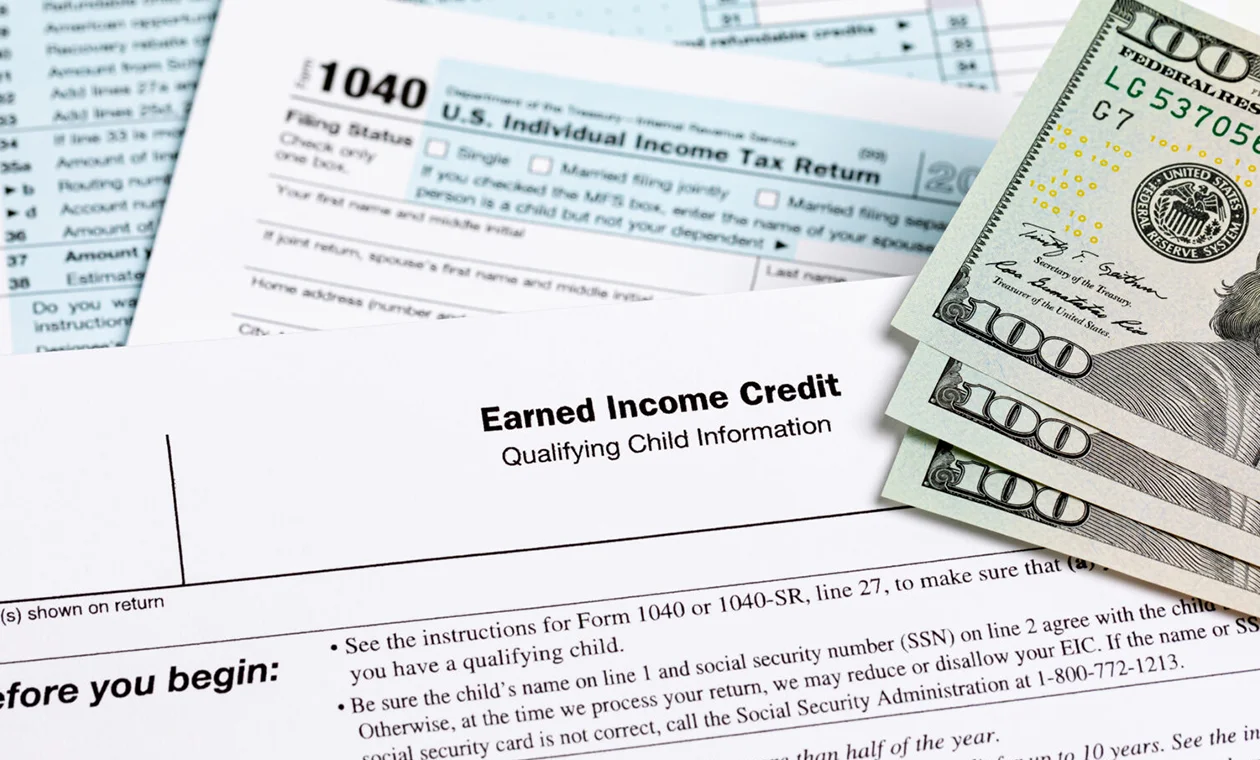The Earned Income Tax Credit is one of the most valuable credits available in the U.S. Plus it’s refundable even if you don’t owe any federal income tax. That money could help cover essentials, reduce debt, or go toward savings.
Yet millions of Americans miss out on it each year because they don’t know if they qualify.
This guide will help you get the refund you deserve without any confusion.
The EITC Explained: What Is It and How Does It Work?
The Earned Income Tax Credit (EITC) is a valuable tax break for people who earn income from a job or self-employment. If you’re working and meet the income limits, you may qualify.
What sets the EITC apart is that it’s refundable. Unlike other credits that only reduce your tax bill, this one can result in a payment from the IRS, even if you owe nothing.
The EITC exists to support working families and individuals, reduce financial strain, and strengthen the economy by increasing take-home income for those who need it most.

Who Qualifies for EITC? (The 7-Point Criteria)
Not everyone qualifies for the Earned Income Tax Credit, but if you’re working and earning a modest income, there’s a good chance you do. Here’s what the IRS looks at when determining eligibility:
1- You Must Have Earned Income
Your income must come from a job (wages, salaries, tips, taxable employee pay, union strike benefits, certain long-term disability benefits received before minimum retirement age) or self-employment (net earnings). Passive income sources like dividends, interest, or rental income do not count as earned income for EITC purposes.
2- Valid Social Security Numbers Required
You, your spouse (if filing jointly), and any qualifying children you claim must each have a valid Social Security Number (SSN) that is valid for employment. Individual Taxpayer Identification Numbers (ITINs) are not sufficient for EITC purposes.
3- Filing Status Matters
You cannot claim EITC if your filing status is “Married Filing Separately” in most cases.
Exception:
You may qualify if you file as “Married Filing Separately” AND you had a qualifying child who lived with you for more than half of 2024, AND you either:
- Lived apart from your spouse for the last six months of 2024, or
- Are legally separated by state law under a written separation agreement or decree of separate maintenance and did not live in the same household as your spouse at the end of 2024.
Accepted filing statuses for EITC generally include Single, Head of Household, Qualifying Surviving Spouse, and Married Filing Jointly.
4- Income Must Be Below IRS Limits (for Tax Year 2024)
Both your earned income and your Adjusted Gross Income (AGI) must be below specific thresholds, which depend on your filing status and the number of qualifying children you have.
Loading..........
The Data is Not Available
5- U.S. Citizen or Resident Alien
You must be a U.S. citizen or a resident alien for the entire tax year. You cannot claim EITC if you file Form 2555, Foreign Earned Income, or Form 2555-EZ, Foreign Earned Income Exclusion.
6- Investment Income Threshold
Your total investment income for 2024 must be $11,600 or less. This includes interest, dividends, capital gains, and certain other investment-related income.
7- Qualifying Child Rules (if applicable)
If you are claiming the EITC with qualifying children, they must meet specific IRS criteria for relationship, age, residency, and joint return:
Relationship Test:
The child must be your son, daughter, stepchild, adopted child, foster child, brother, sister, half-brother, half-sister, stepbrother, stepsister, or a descendant of any of them (e.g., your grandchild, niece, or nephew).
Age Test
The child must be:
- Under age 19 at the end of 2024 and younger than you (or your spouse if filing jointly), OR
- Under age 24 at the end of 2024 and a full-time student, OR
- Any age if permanently and totally disabled at any time during the year.
Residency Test:
The child must have lived with you in the United States for more than half of 2024. Special rules apply for children born or who died during the year, or for temporary absences due to special circumstances (e.g., school, vacation, medical care, military service).
Joint Return Test:
The child cannot file a joint tax return for 2024 unless it’s solely to claim a refund of withheld income tax or estimated tax paid.
EITC Without Children (Age Requirements):
Even if you don’t have qualifying children, you may still qualify. In this case, you (and your spouse if filing jointly) must:
- Be at least 25 years old but under 65 years old by the end of 2024.
- Not be claimed as a qualifying child on anyone else’s tax return.
- Have lived in the United States for more than half of 2024.
How to Calculate Your Earned Income Tax Credit (EITC)
The Earned Income Tax Credit (EITC) is not a single formula. Instead, it depends on factors like your earned income, filing status, and number of qualifying children. The IRS uses a three-phase system to determine your credit: it increases as your income rises, reaches a plateau, then gradually phases out as your income exceeds certain limits.
Step 1: Know What Counts as Earned Income
Your earned income includes wages, salaries, tips, and net earnings from self-employment. It doesn’t include passive income like dividends or interest. If you’re self-employed, your net earnings count (after subtracting expenses and half your self-employment tax).
Step 2: Find Your Maximum Credit (2024 Limits)
For the 2024 tax year, the IRS sets the following maximum EITC amounts:
- No qualifying children: up to $632
- One qualifying child: up to $4,213
- Two qualifying children: up to $6,960
- Three or more qualifying children: up to $7,830
Step 3: Understand How the Credit Is Applied
The EITC calculation follows this pattern:
- Phase-In: As your income increases, so does your credit, up to a set amount.
- Plateau: Once you hit the maximum income range, your credit stays steady.
- Phase-Out: When your income passes a threshold, the credit gradually decreases to zero.
The exact thresholds depend on your filing status and number of children.
Step 4: Compare Earned Income vs. AGI
The IRS uses the lower of your earned income or adjusted gross income (AGI) to determine your credit. This prevents high earners from qualifying through unearned income alone.
When Will I Get My Refund?
If your refund includes the Earned Income Tax Credit (EITC) or the Additional Child Tax Credit (ACTC), the IRS is still legally required to hold the refund until at least mid-February. This measure helps the IRS combat fraud and verify the legitimacy of claims.
Even if you filed your tax return early in the tax season (for example, in late January or early February), if your refund includes the EITC or ACTC, you can generally expect to receive it by early March. This assumes there are no other issues with your return and that you filed accurately and completely.
For the information on the status of your refund, read How Long Does It Take To Get Tax Refund? Complete Guide For USA
You can use the IRS’s “Where’s My Refund?” Tool to track it.
FAQs
The Earned Income Tax Credit (EITC) is based on your income and earned wages, whether or not you have children. The Child Tax Credit (CTC), on the other hand, is specifically for taxpayers with qualifying children. Many people can claim both credits on the same return if they meet the requirements.
Yes. If you’re self-employed, your net earnings from self-employment count as earned income for EITC purposes. You’ll typically report this income on Schedule C when filing your Form 1040. Just be sure your records are accurate—net income, not gross, is what matters.
In most cases, no. An EITC refund is not considered income when determining eligibility for programs like SNAP, Medicaid, or public housing. That means you can receive your credit without worrying about it reducing your access to essential benefits.
If you’re audited, the IRS may request documentation to verify your income, dependents, or filing status. It’s important to keep accurate records, such as pay stubs, tax forms, and proof your child lived with you. Errors or false claims can lead to delays, repayment of the credit, or even being barred from claiming it in future years. That’s why working with a pro like Legend Fusions USA helps you stay prepared and protected.
Yes. Filing as Head of Household typically allows for a higher income threshold and a larger EITC compared to filing as Single. To qualify, you must be unmarried, pay more than half the cost of maintaining a home, and have a qualifying person living with you for over half the year.
Don’t Miss Out on the Refund You Deserve
The Earned Income Tax Credit (EITC) can make a meaningful difference in your financial year. But getting it right matters.
At Legend Fusions USA, we’re here to make sure you don’t leave money on the table. Get expert guidance so you claim what you’ve earned accurately, legally, and stress-free.
Contact us today and let’s make tax season work for you.

Hira Asif
Hira Asif, Client Manager (US) at Legend Fusions, brings over 11 years of tax expertise, including 8 years with Ernst & Young. Her work focuses on tax advisory, compliance, and planning for individuals, partnerships, and private equity funds. With a deep knowledge of federal, state, and local tax regulations, Hira is skilled in identifying tax planning opportunities and reviewing corporate and partnership tax returns to optimize compliance and reduce exposures.

